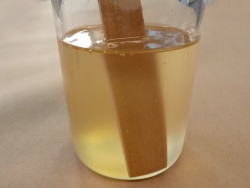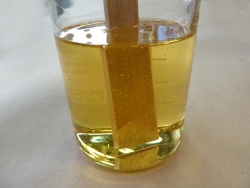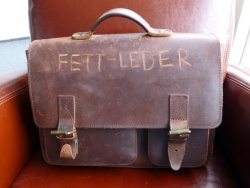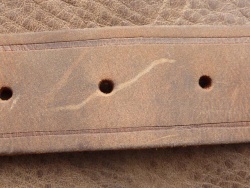Difference between revisions of "Oils & fats in the leather industry"
| Line 37: | Line 37: | ||
==Fatliquoring == | ==Fatliquoring == | ||
| − | + | Fatliquoring refers to the refatting of [[leather]] with water-soluble oils. This can be done in the tanning process or even after [[Washing and dry cleaning leather|dry cleaning]]. Dry cleaning is a cleaning process in a solvent bath which strongly degreases the leather. The fatliquor makes the leather supple and stable and the "starved" look of the degreased leather gets a handsome appearance again. | |
==Fats in [[leather care]] and [[finish]]== | ==Fats in [[leather care]] and [[finish]]== | ||
| − | + | Leather is not only greased and oiled in the [[leather production|production]] to make it supple and soft. Fats and oils are also used as [[leather care]] in order to correct wear (in particular, [[Shoe care|shoe polish]]), or to [[Waterproofing leather|waterproof]] leather, or to preserve old and dry leather by re-greasing and softening. | |
| − | Oils, greases and waxes are also used in the [[finish]]. In case of [[Pull up leather - Greased leather - Waxed leather - Oiled leather|pull | + | Oils, greases and waxes are also used in the [[finish]]. In case of [[Pull up leather - Greased leather - Waxed leather - Oiled leather|pull up (greased leather - waxed leather - oiled leather)]], these substances are used to achieve certain effects in the surface. [[Pull up leather - Greased leather - Waxed leather - Oiled leather|Pull-up]] usually hase a [[Antique Leather - Vintage Leather#patina|patina optics]] which increases with the time. |
Revision as of 23:36, 23 November 2016
Contents
Oils, fats and waxes in the leather production
Der Einsatz von Fetten, Ölen und Wachsen in der Lederherstellung ist ein wichtiger Prozess. Die Substanzen werden in der Produktion eingesetzt, um bestimmte Eingenschaften (Weichheit, Imprägnierung zu erreichen oder um das Aussehen) zu beeinflussen. Aber auch in der Lederpflege spielen Fette, Öle und Wachse eine große Rolle.
Aber selbst bei einigen Gerbarten spielen Fette eine wichtige Rolle. Bei der Trangebung oder Hirngerbung sind die fettenden Substanzen wichtig für die dauerhafte Konservierung der Haut. Man nennt diese Methoden der Lederherstellung auch Fettgerbung.
Fatliquoring (regreasing)
Beim Gerben werden die vom Tier noch vorhandenen Fette von der Rohhaut entfernt, da diese nicht konserviert sind und ranzig würden. Um ein weiches oder stabiles Leder zu erhalten, muss es rückgefettet werden. Schon zu Beginn der Gerbung wurde Leder daher mit Milch, Hirn, Eigelb, Pflanzenöl oder Fischtran (auch „Fischöl“ genannt) rückgefettet. Fette wurden auch für die sogenannte Fettgerbung verwendet. Daher hat fertiges Leder einen Fettgehalt von einem (sehr trockenes Leder) bis zu 25% (Fettleder).
Die Fettung hat auch Einfluss auf den Ledergeruch. Wobei es nur ein Teil der vielen Geruchsstoffe eines fertigen Leders ausmacht. Rückfettungsmittel guter Qualität haben aber keinen störenden Eigengeruch.
Raw materials for the fatliquoring agents
Sea animals oils: Fish oil
Land animal oils and fats: Claw oil, beef tallow, pig fat, bone fat
Vegetable oils and fats: Palm oil, sunflower oil, rapeseed oil, soybean oil, coconut fat, palm kernel fat, turkey red oil
Waxes: Carnauba wax, montan wax, wool grease
Synthetic fats: Paraffin oil, mineral oil, fatty alcohol, fatty acid ester
Fish oil - Claw oil
Fatliquoring
Fatliquoring refers to the refatting of leather with water-soluble oils. This can be done in the tanning process or even after dry cleaning. Dry cleaning is a cleaning process in a solvent bath which strongly degreases the leather. The fatliquor makes the leather supple and stable and the "starved" look of the degreased leather gets a handsome appearance again.
Fats in leather care and finish
Leather is not only greased and oiled in the production to make it supple and soft. Fats and oils are also used as leather care in order to correct wear (in particular, shoe polish), or to waterproof leather, or to preserve old and dry leather by re-greasing and softening.
Oils, greases and waxes are also used in the finish. In case of pull up (greased leather - waxed leather - oiled leather), these substances are used to achieve certain effects in the surface. Pull-up usually hase a patina optics which increases with the time.
Pull up leather - Waxed leather
Additional information
- Pull up leather - Greased leather - Waxed leather - Oiled leather
- Leather care
- Shoe care
- Tanning with fats and oils
Video about the leather production
The leather production in a modern tannery.












 a kotori web solution
a kotori web solution